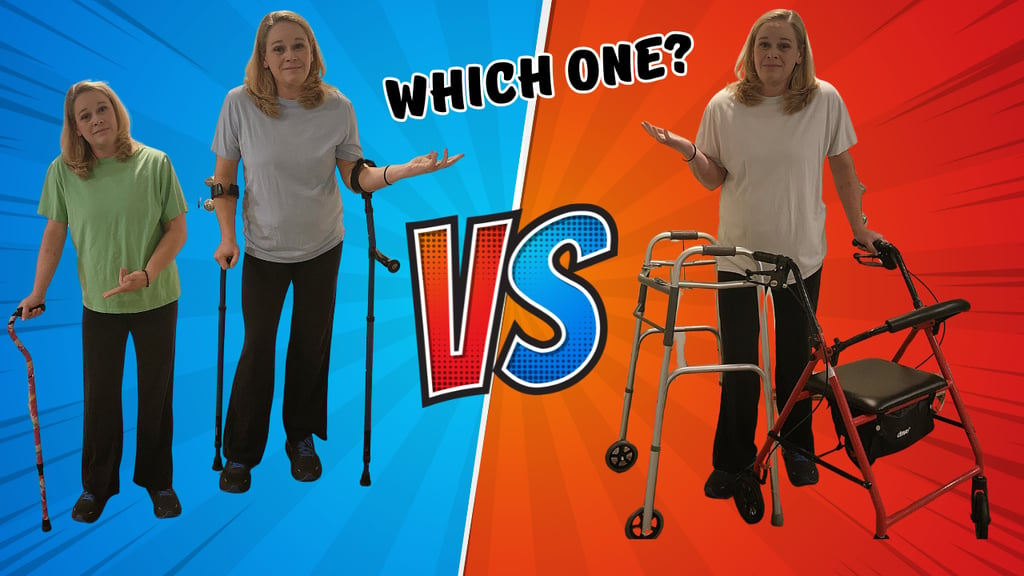From crutches, to canes, to walkers: How to Pick the Best Mobility Aid
How to select the best mobility device to fit your lifestyle and physical needs, explore pros/cons, and how to measure and fit.
1/13/2025


👉🎥Watch these Videos:
👉You don’t think you need a cane or walker!? https://youtu.be/KC1HrcI_F0Y
👉Factors you need to know in order to make the best decision! https://youtu.be/vU8i21B7JN8
👉Now which one to choose- types/ pros/ cons? https://youtu.be/LvrNGRDCo54
Find the Perfect Fit: A Guide to Choosing Your Mobility Aid
Sometimes, life gives us a nudge (or a full-on shove) into considering a mobility aid. Maybe you’re recovering from an injury, navigating a chronic condition, or simply finding your balance isn’t what it used to be. Whatever brought you here, know this: choosing the right mobility aid can make life smoother, safer, and a whole lot less stressful.
Here’s a breakdown to help you understand your options, figure out the best fit for your needs, and even add a touch of personality to your new mobility companion.
Why Should You Consider a Mobility Aid?
First things first: using a mobility aid is not a sign of giving up. It’s a smart move to keep you active, independent, and safe. Here are some top reasons to consider one:
Prevent Falls: If balance feels wobbly, a mobility aid can offer that extra stability.
Reduce Pain: Taking pressure off joints or injuries can make walking much more comfortable.
Conserve Energy: If fatigue hits hard, a mobility aid can help you move more efficiently.
Navigate Life’s Surfaces: From uneven sidewalks to narrow doorways, the right device makes all the difference.
What Types of Mobility Aids Are Out There?
Mobility aids come in many shapes and sizes, each with unique features for specific needs:
Crutches:
Axillary Crutches: The traditional underarm type, for short-term use.
Forearm Crutches: (aka Lofstran Crutches) Better for long-term needs, offering more control and comfort.
Canes:
Straight Cane: Lightweight and great for mild balance issues.
Quad Cane: Offers extra stability with a wider base (but can be trickier on stairs).
Walkers:
Standard Walker: The most stable option, but requires lifting between steps.
Rolling/Front-Wheeled Walker: Adds wheels to glide forward, great for people with less arm strength.
Rollator: Includes wheels, a seat, and often storage—perfect for a mix of mobility and convenience.
How to Choose the Right Mobility Aid
Choosing the right device depends on several factors:
Balance and Strength: Canes work for mild instability, while walkers are better for significant support.
Energy Levels: Rollators and wheeled walkers reduce effort for people who tire easily.
Home Layout: Consider door widths (standard is 32 inches) and maneuverability in tight spaces.
Lifestyle Needs: Do you need to carry items? Look for walkers or rollators with trays, bags, or storage.
Transportation: Foldable designs are ideal if you need to stash your device in a car.
How to Measure for a Proper Fit
A mobility aid that doesn’t fit well can cause more harm than good. Here’s how to measure:
Canes and Walkers:
Way #1: Stand upright with arms relaxed at your sides. The handle should align with the crease of your wrist.
Way #2: Stand holding on to the cane or inside the walker holding on to the grips and the height should fall leaving about 15-30 degrees bend in your elbows, this usually falls about at the top of your hips.
Crutches:
For axillary crutches, place the tips on the ground 6inches out in front of your toe and 6inches out to the side, then ensure 1-2 inches (or 2-3finger widths) of space between the underarm pad and your armpit.
Then adjust the full height of the crutches and if need the Handgrip height. In the position above you want the height of the crutches and handgrips to fall where you have about 30 degree bend in your elbows.
Forearm crutches should have the cuff sit 1-2 inches below the elbow.
Accessories to Enhance Your Mobility Aid
Make your mobility aid work harder (and look cooler) with these add-ons:
For Walkers/Rollators:
Trays, bags, or cup holders for hands-free carrying.
Cushioned grips for comfort.
Seats for rest breaks.
For Canes/Crutches:
Non-slip tips for better traction.
Wrist straps to keep them close.
Personalization:
Add flair with colored duct tape, patterned wraps, or fun accessories to match your style.
A Quick Word on Bariatric Devices
For individuals with larger body types, bariatric options provide the extra support and durability needed. Keep in mind these devices may be bulkier and pricier, so balance functionality with ease of use.
Wrap-Up: Owning Your Mobility Aid
Using a mobility aid isn’t about limitations—it’s about finding freedom. You deserve to move safely and confidently, whether you’re navigating a chronic condition, recovering from an injury, or just taking the pressure off tired joints.
Need help choosing or using your mobility aid? Check out my YouTube channel, where I dive into detailed tutorials, tips, and real-life advice on adaptive living. And remember: a little duct tape and creativity can make any device uniquely yours!
To discover more helpful videos with tips and ticks go to: https://www.youtube.com/playlist?list=PL1OyMZ8X-D1qkX0PsWoKQzBqu-tf2hmfy
Vaccine Injury Healing
© 2024. All Rights Reserved
Brought to you by Dr. Nikki Holland
